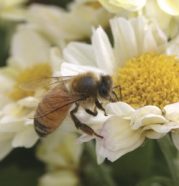Little bee brains that could
A honeybee's tiny brain has an awesome working memory.
Share this:
- Share via email (Opens in new window) Email
- Click to share on Facebook (Opens in new window) Facebook
- Click to share on X (Opens in new window) X
- Click to share on Pinterest (Opens in new window) Pinterest
- Click to share on Reddit (Opens in new window) Reddit
- Share to Google Classroom (Opens in new window) Google Classroom
- Click to print (Opens in new window) Print
By Emily Sohn
If “birdbrain” is supposed to be an insult, then “bee brain” might be an even crueler thing to say. Bees have tiny brains, after all, so it’s easy to believe that they must be dumb.
Clever things often come in small packages, however. New research shows that, when it comes to something called “working memory,” honeybees rank right up there with bigger-brained animals such as birds and monkeys.
 |
|
The honeybee’s brain provides a working memory that’s as robust as a bird’s and approaches the flexibility of a monkey’s.
|
| J. Wilson |
Working memory is a type of short-term memory. It’s what your brain does between the time you look up a phone number and when you punch the number into the phone. Bees don’t use telephones, but scientists can test their working memories in other ways.
In one recent study, researchers from the Australian National University in Canberra put honeybees inside a long tunnel that led into an upright pipe. The bees could escape through either side of the pipe, but the two sides of the pipe were each marked with a different pattern, such as stripes slanting to the left or to the right. Only one side was the “right” way to go to reach a feeder with sugar water.
Before the bees could get to the pipe, they had to fly through a partition in the tunnel. This partition was marked with a pattern, too, and the bees were supposed to leave the pipe through the side marked with the same pattern to get the treat.
 |
|
To earn a reward, a bee flying along a tunnel (from bottom) had to notice the pattern on a partition that it flew through, then enter a decision chamber (middle) and choose the opening with the same pattern (left) as it had seen on the tunnel partition.
|
| Courtesy of Shaowu Zhang |
Once the bees learned how to do this, the researchers made the tunnel longer and longer, so the bees had to go farther between seeing the first pattern then having to choose the appropriate path. This became a test of how long bees could remember a pattern.
The results showed that a bee’s working memory lasts for about 5 seconds. That’s similar to the length of short-term memory in birds when they do a test like this.
Outside, bees tend to visit flowers similar to ones they visited 5 seconds earlier. Their memories help them collect food faster by visiting a lot of flowers that they already know how to handle. This also helps plants, too, making pollination more efficient.
Bee memories also seem to be remarkably flexible. In an even more challenging test, the scientists put two partitions in the tunnel, each with a different pattern.
The bees were able to learn how to pay attention to just one of the partitions—the first one, for instance, or the one placed a certain distance from the pipe. They were even able to do this with patterns they had never seen before.
So, if some bully calls you a bee brain, thank him for the compliment, then walk away.
Going Deeper:
Milius, Susan. 2005. Little brains that could: Bees show big-time working memory. Science News for Kids 167(April 2):213. Available at http://www.sciencenews.org/articles/20050402/fob6.asp .
You can see a movie of a bee using its working memory here. Warning: large file (6.4 MB). The experiment was carried out in the All Weather Bee Flight Facility at the Australian National University’s Research School of Biological Sciences. The video shows the apparatus used in the experiment. It consisted of a 7.2-meter-long tunnel with a decision chamber attached to the far end. The sample pattern consisted of slanted blue lines on a partition in the tunnel. A trained bee would fly into the tunnel, through the sample pattern, and enter the decision chamber. In the decision chamber, it had to choose between two patterns, one of which matched the sample pattern encountered earlier and led to a reward.







